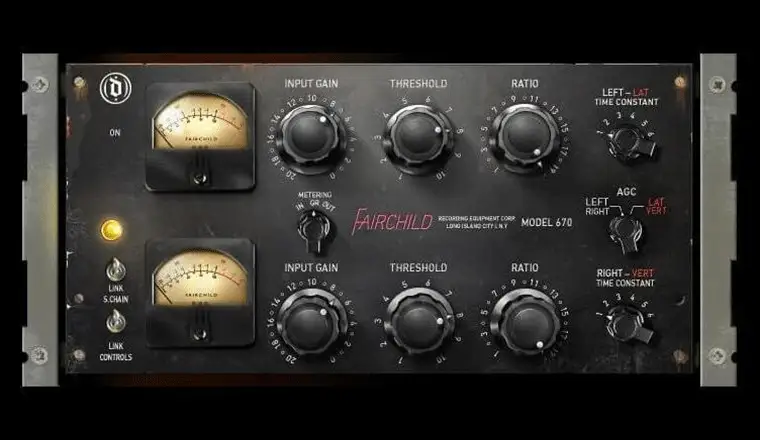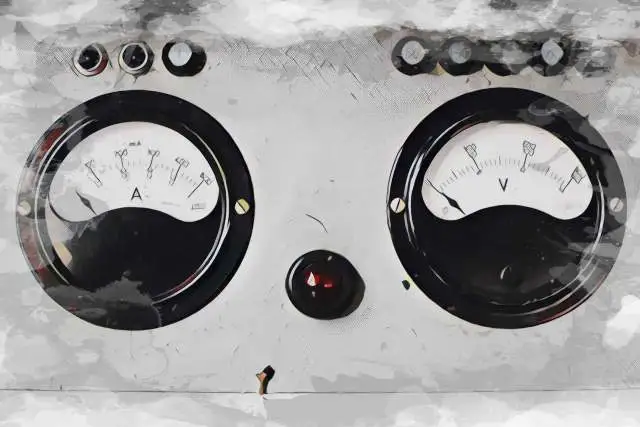Once you delve deep into the world of music production, it's not uncommon to get lost in the maze of post-production tools of yesteryear and today.
One of the unsung heroes of audio compression is the so-called Variable Mu compression.
Variable mu compressors are used both in music mixing and mastering, and they've been around for decades. Like most modern compressors, they started out as hardware units and were later recreated digitally because of their unique sonic characteristics: a warm and enveloping sound that enhances the true nature of vocals and instruments.
Still today, the variable mu limiter compressor remains a sought-after tool for its musical approach to dynamic control.
But that’s not all! Vari-mu provides a clear and seamless compression that works magnificently in vocals and drums alike, meaning it can help your songs sound more cohesive without affecting the instrument’s unique characteristics.
In this article, we’ll discuss everything about the variable mu compressor: its history, functionality, and the distinctive sound that sets it apart.
Let’s dive in!
Variable Mu Compression: A Definition
The best way to understand vari-mu compression is by clarifying why it’s called this way.
Generally in audio engineering, the Greek letter μ (or mu) is used to identify the gain, and therefore, variable-mu means "variable gain" or "changing gain."
Variable mu compressors use vacuum tubes as the main point of their gain reduction control circuit. Normally, compressors use a vacuum tube for amplification in the makeup gain stage, but in the case of variable-mu compressors, vacuum tubes are used as attenuators.
Furthermore, these compressors use a remote cut off tube to create a characteristic smooth effect. As the input signal being fed into the compressor increases in amplitude, the current being sent to the vacuum tube’s grid decreases, which reduces the output level of the compressor.
In other words, when the input signal increases, the compressor adjusts its behavior dynamically, which is essentially what sets vari-mu compression apart.
Unlike VCA or optical units, vari-mu compressors achieve compression with the interaction between signal amplitude and tube biasing. As a result, variable-mu compressors can be referred to as "variable gain" or "delta mu," where delta is the difference in quantity. From now on, you'll see variable-mu shortened to "vari-mu."
What Makes It Special?
What made vari-mu compression stand out when it became popular was how it responded to the incoming audio signal, applying just the right amount of gain reduction, subtle and yet powerful enough to enhance an instrument.
Let’s summarize how vari-mu compression differs from all the other most popular compressors:
- Transparent Compression : Vari Mu compressors tend to apply a gentle compression that adds warmth without harshness. As a result, they’re great as an all-round subtle compressor, but also for mastering, vocals, and bus compression.
- Variable Ratio : The compression ratio increases as the input signal gets louder. This is a great characteristic, especially when you’re working with dynamic sources (like vocals and drums), as it applies light compression on softer signals and more aggressive compression on louder ones.
- Tube Saturation : If you're looking for a timeless analogue sound, a vari-mu compressor will deliver just that. The tubes exude a pleasing harmonic distortion with plenty of depth and character.
- Soft-Knee Compression : This form of compression gradually introduces changes, which gives the mix a musical feel that preserves the nature of the original sound. However, if you're looking for a more aggressive compression, some models also have a sharper knee limit mode.
- Output controls. These controls are great when you adjust the final levels and tonal balance, especially when working with "sensitive" tracks like vocals or orchestral parts.
What’s Best For?
From the previous section, you might have already guessed what Vari-mu compression is really good at.
In a nutshell, this is a great compression for subtle work: it offers a warm and timeless sound without being too obvious, and a level of cohesiveness that brings instruments together without affecting their character. This form of dynamic range compression is fundamental when mixing complex arrangements that require a cohesive sound.
One of the best places to use a vari-mu compressor is on the mix bus, where it helps bring together all the different elements of a song, like drums and vocals, to create a full and engaging sound.
I’ve seen plenty of mastering engineers using it too, because it adds a nice polish to the final mix without changing the original vibe too much.
When it comes to vocals, vari-mu is the go-to compressor for many producers across genres. It enhances warmth and presence and gives singers a natural and slightly richer sound, all without the abruptness of other compressor types.
That said, there’s no limit as to what a vari-mu compressor can do. It works incredibly well on drums because it makes all the different elements blend together seamlessly, but you can also apply it on bass and electric guitars to add a vintage vibe to your sound. When applied moderately to the master bus, a good vari-mu compression can glue a mix together without affecting the clarity of your instruments.
The options are endless.
Best Hardware
Let's start this new section by discussing the best hardware units you can get if you're looking for variable mu compression.
Bear in mind that prices of original compressors from the 60s and 70s can be insanely high, and while you might be one of the lucky few who can spend hundreds of thousands of dollars on a compressor, here I'll talk mostly about reissues and replicas that are, if not cheap, at least more affordable than the originals.
Manley Variable MU Compressor/Limiter
The 1990s Manley Variable Mu is the most popular compression of this kind, and a game-changer for any serious sound engineer (who can afford it).
This dual-channel tube limiter and compressor combines true variable gain and versatility that leaves nothing to be desired, whether tracking, mixing, or mastering.
The transformer-coupled design creates a warm and rich sonic palette that has defined decades of music. Renowned producers and engineers, including the legendary Tom Elmhirst , have used it to create global hits, be it to enhance individual tracks or polish full stereo mixes.
Manley Labs has spent decades refining tube gear for high-end audio applications, and the Manley Vari Mu is still the standard for those who need a tube-based sound with intuitive controls.
Thermionic Culture Phoenix
This new model builds on the classic design of the original Phoenix compressor while adding some modern features, like the HT standby switch, which lets you put the compressor in a low-power mode.
Another fantastic feature is the meter zero control on the front panel, which makes it easy to adjust the levels so both meters read "0" when the compressor is on standby and not compressing.
The side chain filters let you tweak the compression response to specific bass frequencies, either below 150Hz or 300Hz. If you're using it in stereo mode, the filters adjust based on the average of both channels, giving the option to use five different frequency options.
What most people love about the Phoenix is the smooth soft knee compression: it has a subtle yet distinctive signature that keeps the sound quality intact while subtly controlling the dynamic range.
If you need a bit more punch, you can simply drive it harder, and the compressor will bring to life a powerful harmonic distortion and higher ratio compression.
Finally, with a stereo link switch, you can let the compression react uniformly across both channels, preserving or even highlighting stereo imaging.
Fairchild 670

The FAIRCHILD 670 is a replica of the original and legendary compressor that’s still considered a sort of "holy grail" of dynamics processors.
The FAIRCHILD 670 can work in both mono and stereo modes and offers six different time constants to choose from. It has controls for threshold, compression, and makeup gain, as well as VU metering for monitoring.
The device is built with custom-designed, high-quality output transformers, is hand-wired, and comes with rich tube amplification including the 6386, 12AX7, 6973, 12BH7, E80F, 5651, EL34, and GZ34 tubes.
The controls include two input gain knobs that adjust in one-decibel steps, two adjustable threshold knobs, and two time-constant switches that allow you to select fixed or variable settings. There are also two metering switches for monitoring the tube’s performance and a mode switch for different limiting settings. Some versions also offer a ganged input control to calibrate both channels.
While a replica, the FAIRCHILD 670 is a phenomenal piece of gear that combines modern requirements with a timeless sound that works across genres. If you can afford it, this compressor can revolutionize your productions.
Retro Instruments 176
The Retro Instruments 176 is another modern reinterpretation of a classic: the UA 176.
The 176 features the authentic variable-mu tube design and four compression ratio options ranging from gentle compression to limiting. Adjusting the input level defines how much compression is applied, but also affects the tube saturation and overall tone.
It includes a sidechain high-pass filter, a vocal asymmetry tool, and hard-wire and interstage transformer bypass switches. The vintage VU meter shows input, output, or gain reduction levels. It also comes with a balance test for tubes to connect multiple units in stereo.
20 dB of gain reduction, a signal-to-noise ratio lower than 76 dB, a flat frequency response within 0.5 dB from 20 Hz to 20,000 Hz, and a harmonic distortion below 1% with low gain reduction levels are only some of the unique characteristics of this phenomenal compressor.
All in all, these are some of the best value-for-money vari-mu compressors you can find these days. It captures the sound of the original model from the 1960s while offering the modern features we all need when making music.
Gates STA-Level
Original models are rare and extremely expensive, but Retro Instruments has carved a market for itself by creating new versions that keep the main features of the originals while adding modern improvements. That’s the case with Retro Instruments’ reissue of the iconic Gates Sta-Level.
This updated Sta-Level can be used in three modes: Single, Double, or Triple, with a six-position switch for adjusting the release time. These modes can bring to life a wide variety of responses; for instance, the Double mode recreates a typical vintage sound, while the Single mode gives a slower reaction with enhanced transients.
The Triple mode is good for vocal compression, with quick attack times and slower releases that prevent sonic artefacts.
Inside, two tubes handle the gain-reduction, and since the original valves are quite expensive, Retro has replaced them with similar tubes that can easily be swapped back. With this one, you also have the option to use a rare 6386 valve.
Best Plugins
In recent years, plugins have gotten better and better at emulating the sound of vintage gear, and the variable mu compression plugins are no exception.
Here are some I've had the chance to try or see over the years. Prices vary greatly but are nowhere near as expensive as their analogue counterparts, so if you're looking for a way to try this type of compression without spending a lot, keep reading.
Pulsar Mu
The Pulsar Mu is designed to recreate the low-distortion compression of the Fairchild 660/670 and Altec 436B into your DAW. It does so with remarkable transparency even at high gain reduction, which adds cohesiveness to all buses, mixes and masters.
It comes with a plethora of cutting-edge tools, like a look-ahead limiting, a versatile sidechain EQ, mid-side processing, external sidechain options, and advanced metering. If you’re after the unique sound of a variable-gain tube compressor, the Pulsar Mu is a phenomenal option.
Just like the compressors it’s inspired by, this plugin offers a transparent yet rich sound, handling transients in a subtle way that works very well across genres.
But the Pulsar Mu does more than just replicate. It includes a full sidechain EQ section to control how the compressor reacts to specific frequencies and a modern metering section that allows subtle adjustments to your compression settings, showing both waveform and gain reduction in real time and over time.
UAD Vari Mu

The UAD Manley Variable Mu perfectly recreates the variable-gain behavior found in the legendary hardware: smooth and transparent gain reduction with a warmth and richness that can turn every mix into a cohesive composition.
Many high-end hardware units feature stereo input control, which allows to adjust the left and right channels during compression, and the UAD Vari Mu offers that, too. It comes with both Left/Right and Mid/Side modes and the option to link channels for a strong stereo image. There's also a simple Dry/Wet Mix control to apply parallel compression.
With presets available from iconic producers like Tom Elmhirst, J.J. Blair, and Mike Larson, this plugin offers a great way to get started in the world of vari-mu compression.
DDMF MagicDeathEye
The MagicDeathEye is inspired by the great Fairchild 660 compressor. It comes with six timing settings, three attack settings, an optional 150Hz sidechain high-pass filter, and adjustable gain.
It provides mono and stereo processing and fits well with mastering tracks or pre-mastering. It has a custom compression curve and was designed by the legendary mastering engineer Ian Sefchick.
At less than $100, the MagicDeathEye is a great opportunity for those who want to try out the power of vari-mu compression in their DAW.
Klanghelm MJUC
For roughly $30, Klanghelm's MJUC plugin is quite an impressive tool that makes tube compression a walk in the park.
The MJUC features three different models, each with its own unique sound and controls. The plugin also includes TIMBRE and DRIVE knobs to shape the tone and saturation. The DRIVE knob adjusts the signal’s warmth, affecting both the input and output along with the tube saturation, and the TIMBRE knob fine-tunes the sound to fit your requirements.
User-friendly and budget-friendly, the MJUC is a great compressor if you’re just getting started.
Dyna-Mu
The Dyna-Mu by IK Multimedia’s technology is another plugin that's managed to revive the timeless sound of analogue vari-mu compression.
It works magnificently when mastering, but does a great job also when working on single tracks: the subtle warmth and depth it provides can enhance the beauty of vocals, drums, and guitars in unique ways, and when pushed to its limits, it can add a vibrant color to mixes and single tracks alike.
The controls on the Dyna-Mu are designed to be user-friendly and work quickly: the input adjusts how much signal goes into the compressor, and the threshold sets the level at which the compressor starts working.
It’s another inexpensive but reliable option for those looking for realistic, analog-like vari-mu compression.
Final Thoughts
I hope this article will inspire you to try out a vari-mu compressor, whether in a physical or digital form!
In my experience, variable mu compression is versatile and powerful enough to work with any instrument or genre, as long as you take your time understanding the tool you have in your hands. It can also be used at any stage of your production process, which is great if you want to experiment with your sound and create a unique sound signature.
As you can see from the list above, there's no limit as to how much you can spend on a high-quality compressor, so my recommendation is to start with a cost-effective option, like a plugin, and once you have mastered it, choose whether a vintage vari-mu compressor is the right option for your needs.
Good luck, and stay creative!





